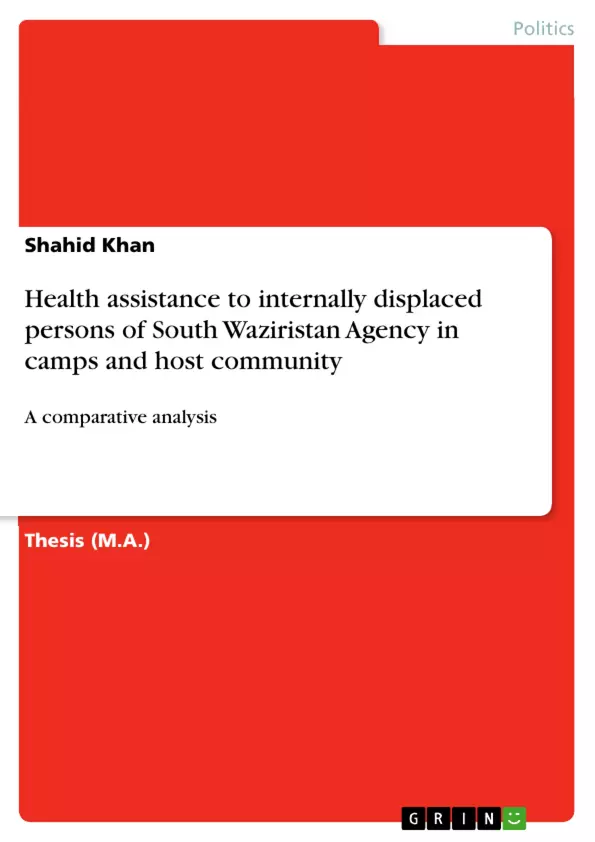Since 2009, South Waziristan Agency (SWA) has suffered a number of violent armed conflicts between security forces and Taliban causing massive destruction, several thousand deaths and creating over a half million displaced people. Right at the start of this armed conflict, the displaced people from SWA took flight to district Tank. The recipient area was selected for this study because it is among the most backward areas in Khyber Pakhtunkhwa (KP) , hosting IDPs from the most neglected agency of federally administrated tribal areas (FATA).
Government failed in providing adequate health care support to IDPs due to the absence of legislation regarding their rights in national law. Further, due to negligence of issues related to internal displacement in UN and international law, IDPs were afforded very little health care help during displacement.
This research was designed to contribute to a policy or model to be developed to provide health care services for IDPs. The three objectives of this study were: to evaluate the role of economic and social capital level of SWA IDPs in selection of temporary shelter in IDPs camp and host community during armed conflict; to compare the prevalence of health related problems in IDPs living in camp and host community according to their sex and age; to indicate the difference between current nature and range of health services availability in IDPs camp and host community according to their sex and age.
The research employed mixed methods in achieving the above objectives. It was conducted through surveys and in-depth interviews (IDIs) with IDPs. Respondents for surveys were selected by applying systematic sampling technique with a random start. For this purpose 155 HHs were selected for survey & 5 respondents for IDIs in IDPs camps while in host community 105 respondents were selected for survey and 3 respondents for IDIs.
This study found that in the situation where government and international community was not interested to help them out during displacement, IDPs relied more on their level of social capital and economic status. Those IDPs who could afford a house or had found help from their relatives, fellow tribesmen or friends joined host community but those IDPs who were poor and unable to find any help regarding shelter, loan or food, were left with only one choice that is to join IDPs camp. [...]
Inhaltsverzeichnis (Table of Contents)
- Executive Summary
- Introduction
- Literature Review
- Methodology
- Findings and Analysis
- Health Needs of IDPs
- Health Care Services Availability
- Comparison of Health Problems
- Social Capital and Economic Status
- Shelter and Housing Situation
- Recommendations
- Conclusion
Zielsetzung und Themenschwerpunkte (Objectives and Key Themes)
This thesis aims to contribute to the development of a policy or model for providing health care services to internally displaced persons (IDPs) in the context of the South Waziristan Agency (SWA) armed conflict. The study focuses on the following key themes:- The role of economic and social capital in IDP shelter selection
- The prevalence of health problems among IDPs living in camps and host communities
- The availability and accessibility of health services for IDPs
- The impact of the conflict on the health needs and health care availability for IDPs
- Recommendations for health sector reform to better address the needs of IDPs
Zusammenfassung der Kapitel (Chapter Summaries)
- The Executive Summary provides a concise overview of the study's objectives, methodology, findings, and recommendations. It highlights the challenges faced by IDPs from the SWA conflict and the need for policy interventions.
- The Introduction provides background information on the SWA conflict, the resulting displacement, and the challenges faced by IDPs in accessing adequate health care.
- The Literature Review examines existing literature on internal displacement, health care provision for IDPs, and the role of social and economic factors in shaping their experiences.
- The Methodology section details the research design, data collection methods (surveys and in-depth interviews), and the sampling techniques employed. It explains the selection of respondents in both IDP camps and host communities.
- The Findings and Analysis chapter presents the study's key findings, focusing on the prevalence of health problems among IDPs, the disparities in health care access between camps and host communities, and the factors influencing IDP shelter choices.
- The Recommendations chapter proposes specific policy recommendations to address the challenges faced by IDPs in accessing health care services. It emphasizes the need for legislative action, international community involvement, and comprehensive policy frameworks.
Schlüsselwörter (Keywords)
This study explores the complex issue of providing health assistance to internally displaced persons, focusing specifically on the situation of IDPs from the South Waziristan Agency in Pakistan. Key themes and concepts examined in this work include internal displacement, conflict, health needs, health care access, social capital, economic status, shelter choices, camp settings, host communities, policy recommendations, and health sector reform. The research sheds light on the vulnerabilities of IDPs during armed conflict and the need for effective policy interventions to address their unique health needs.- Arbeit zitieren
- Shahid Khan (Autor:in), 2014, Health assistance to internally displaced persons of South Waziristan Agency in camps and host community, München, GRIN Verlag, https://www.grin.com/document/276540



